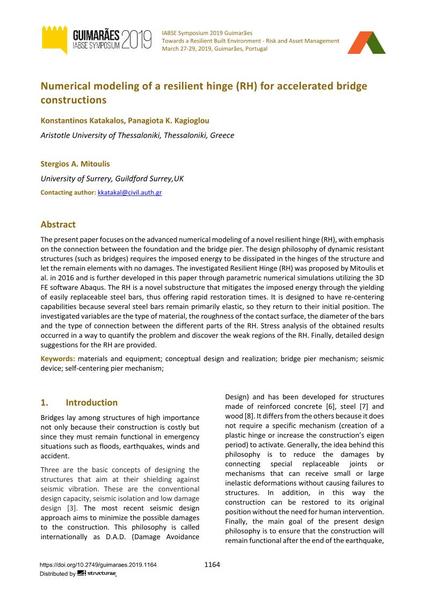Numerical modeling of a resilient hinge (RH) for accelerated bridge constructions

|
|
|||||||||||
Bibliografische Angaben
| Autor(en): |
Konstantinos Katakalos
(Aristotle University of Thessaloniki, Thessaloniki, Greece)
Panagiota Kagioglou (Aristotle University of Thessaloniki, Thessaloniki, Greece) Stergios Mitoulis (University of Surrery, Guildford Surrey,UK) |
||||
|---|---|---|---|---|---|
| Medium: | Tagungsbeitrag | ||||
| Sprache(n): | Englisch | ||||
| Tagung: | IABSE Symposium: Towards a Resilient Built Environment Risk and Asset Management, Guimarães, Portugal, 27-29 March 2019 | ||||
| Veröffentlicht in: | IABSE Symposium Guimarães 2019 | ||||
|
|||||
| Seite(n): | 1164-1172 | ||||
| Anzahl der Seiten (im PDF): | 9 | ||||
| DOI: | 10.2749/guimaraes.2019.1164 | ||||
| Abstrakt: |
The present paper focuses on the advanced numerical modeling of a novel resilient hinge (RH), with emphasis on the connection between the foundation and the bridge pier. The design philosophy of dynamic resistant structures (such as bridges) requires the imposed energy to be dissipated in the hinges of the structure and let the remain elements with no damages. The investigated Resilient Hinge (RH) was proposed by Mitoulis et al. in 2016 and is further developed in this paper through parametric numerical simulations utilizing the 3D FE software Abaqus. The RH is a novel substructure that mitigates the imposed energy through the yielding of easily replaceable steel bars, thus offering rapid restoration times. It is designed to have re-centering capabilities because several steel bars remain primarily elastic, so they return to their initial position. The investigated variables are the type of material, the roughness of the contact surface, the diameter of the bars and the type of connection between the different parts of the RH. Stress analysis of the obtained results occurred in a way to quantify the problem and discover the weak regions of the RH. Finally, detailed design suggestions for the RH are provided. |
||||
